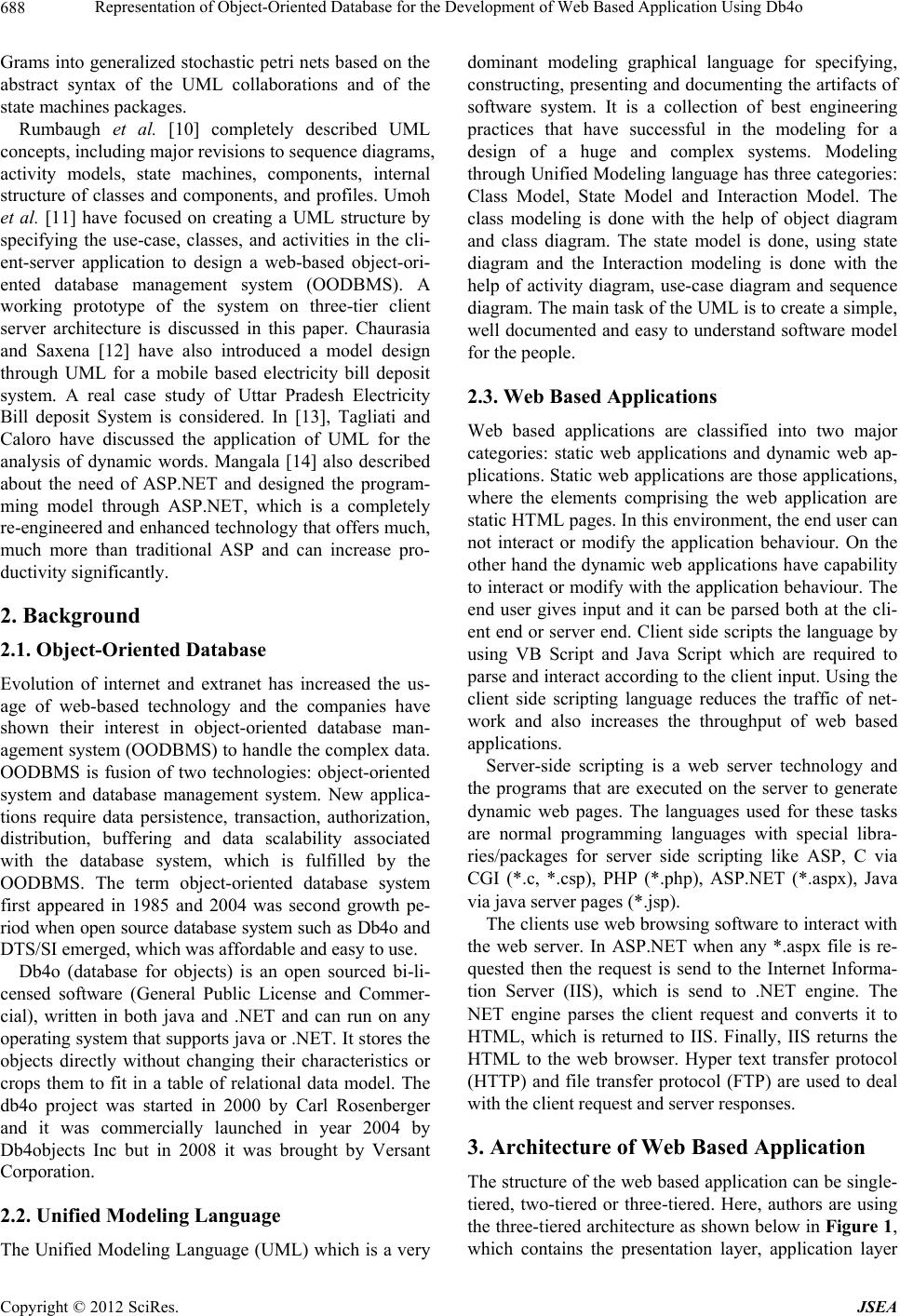
Representation of Object-Oriented Database for the Development of Web Based Application Using Db4o
688
Grams into generalized stochastic petri nets based on the
abstract syntax of the UML collaborations and of the
state machines packages.
Rumbaugh et al. [10] completely described UML
concepts, including major revisions to sequence diagrams,
activity models, state machines, components, internal
structure of classes and components, and profiles. Umoh
et al. [11] have focused on creating a UML structure by
specifying the use-case, classes, and activities in the cli-
ent-server application to design a web-based object-ori-
ented database management system (OODBMS). A
working prototype of the system on three-tier client
server architecture is discussed in this paper. Chaurasia
and Saxena [12] have also introduced a model design
through UML for a mobile based electricity bill deposit
system. A real case study of Uttar Pradesh Electricity
Bill deposit System is considered. In [13], Tagliati and
Caloro have discussed the application of UML for the
analysis of dynamic words. Mangala [14] also described
about the need of ASP.NET and designed the program-
ming model through ASP.NET, which is a completely
re-engineered and enhanced technology that offers much,
much more than traditional ASP and can increase pro-
ductivity significantly.
2. Background
2.1. Object-Oriented Database
Evolution of internet and extranet has increased the us-
age of web-based technology and the companies have
shown their interest in object-oriented database man-
agement system (OODBMS) to handle the complex data.
OODBMS is fusion of two technologies: object-oriented
system and database management system. New applica-
tions require data persistence, transaction, authorization,
distribution, buffering and data scalability associated
with the database system, which is fulfilled by the
OODBMS. The term object-oriented database system
first appeared in 1985 and 2004 was second growth pe-
riod when open source database system such as Db4o and
DTS/SI emerged, which was affordable and easy to use.
Db4o (database for objects) is an open sourced bi-li-
censed software (General Public License and Commer-
cial), written in both java and .NET and can run on any
operating system that supports java or .NET. It stores the
objects directly without changing their characteristics or
crops them to fit in a table of relational data model. The
db4o project was started in 2000 by Carl Rosenberger
and it was commercially launched in year 2004 by
Db4objects Inc but in 2008 it was brought by Versant
Corporation.
2.2. Unified Modeling Language
The Unified Modeling Language (UML) which is a very
dominant modeling graphical language for specifying,
constructing, presenting and documenting the artifacts of
software system. It is a collection of best engineering
practices that have successful in the modeling for a
design of a huge and complex systems. Modeling
through Unified Modeling language has three categories:
Class Model, State Model and Interaction Model. The
class modeling is done with the help of object diagram
and class diagram. The state model is done, using state
diagram and the Interaction modeling is done with the
help of activity diagram, use-case diagram and sequence
diagram. The main task of the UML is to create a simple,
well documented and easy to understand software model
for the people.
2.3. Web Based Applications
Web based applications are classified into two major
categories: static web applications and dynamic web ap-
plications. Static web applications are those applications,
where the elements comprising the web application are
static HTML pages. In this environment, the end user can
not interact or modify the application behaviour. On the
other hand the dynamic web applications have capability
to interact or modify with the application behaviour. The
end user gives input and it can be parsed both at the cli-
ent end or server end. Client side scripts the language by
using VB Script and Java Script which are required to
parse and interact according to the client input. Using the
client side scripting language reduces the traffic of net-
work and also increases the throughput of web based
applications.
Server-side scripting is a web server technology and
the programs that are executed on the server to generate
dynamic web pages. The languages used for these tasks
are normal programming languages with special libra-
ries/packages for server side scripting like ASP, C via
CGI (*.c, *.csp), PHP (*.php), ASP.NET (*.aspx), Java
via java server pages (*.jsp).
The clients use web browsing software to interact with
the web server. In ASP.NET when any *.aspx file is re-
quested then the request is send to the Internet Informa-
tion Server (IIS), which is send to .NET engine. The
NET engine parses the client request and converts it to
HTML, which is returned to IIS. Finally, IIS returns the
HTML to the web browser. Hyper text transfer protocol
(HTTP) and file transfer protocol (FTP) are used to deal
with the client request and server responses.
3. Architecture of Web Based Application
The structure of the web based application can be single-
tiered, two-tiered or three-tiered. Here, authors are using
the three-tiered architecture as shown below in Figure 1,
which contains the presentation layer, application layer
Copyright © 2012 SciRes. JSEA